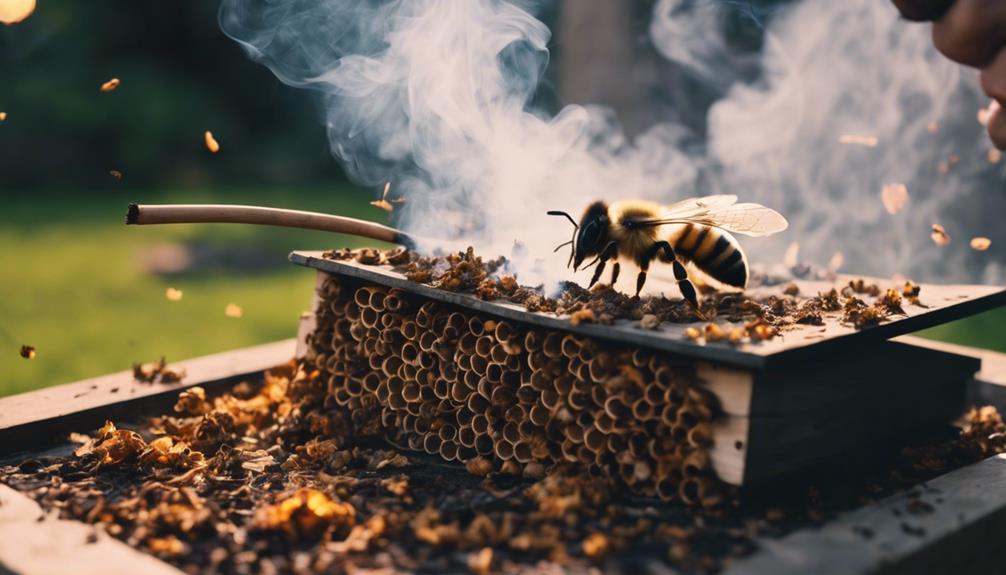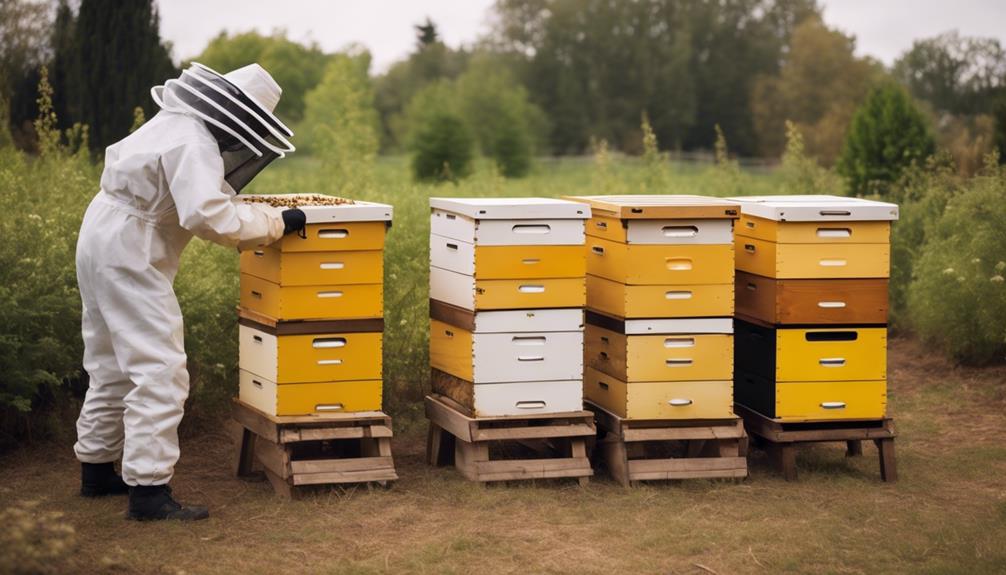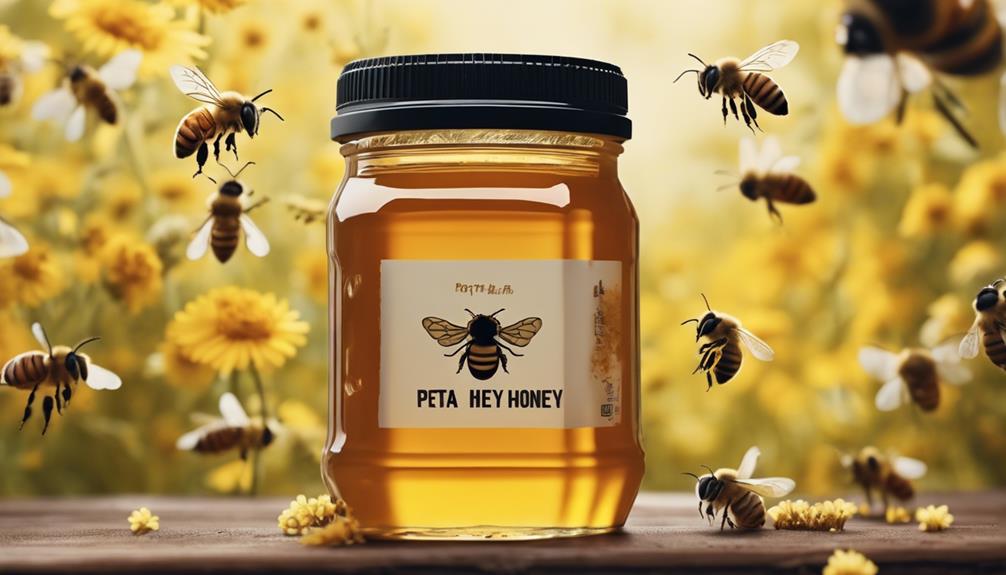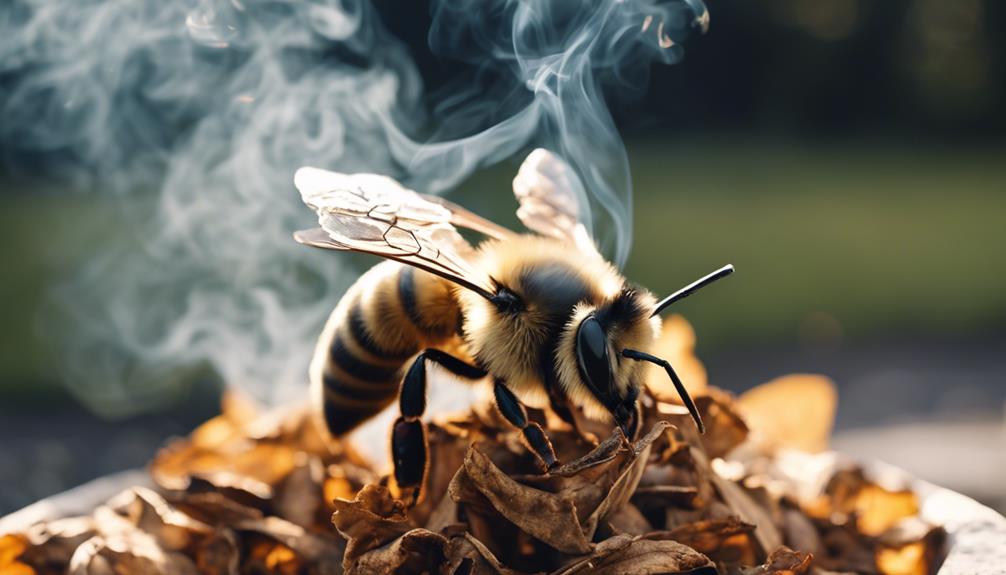
Using leaves in a bee smoker can be a great way to calm our fuzzy friends during hive checks and beekeeping routines. The natural, gentle smoke from burning leaves creates a peaceful environment, helping us work harmoniously with the bees. Types like olive tree leaves, pine needles, and eucalyptus leaves are suitable choices. Remember to crumple or shred leaves for efficient burning and consider layering denser materials for longer-lasting smoke. If you’re curious how to safely use leaves and optimize your beekeeping experience, the benefits and techniques of leaf smoking are worth exploring further.
Main Points
- Dry leaves from various trees like olive, maple, or oak are safe for bee smokers.
- Pine needle leaves and eucalyptus leaves are suitable choices for creating calming smoke.
- Crumple leaves for easy ignition and sustained burning in the smoker.
- Experiment with different leaf types to customize the smoking experience.
- Ensure leaves are completely dry to prevent excessive smoke or harm to bees.
Benefits of Using Leaves in Bee Smoker
When using leaves in a bee smoker, we benefit from the natural, calming smoke that helps soothe bees during hive inspections. The gentle aroma of burning leaves creates a peaceful environment, making it easier to handle our buzzing friends.
Not only does the smoke from leaves help keep the bees calm, but it also assists in relocating hives and clearing bees from specific areas without causing harm. Imagine the harmony of nature as the leaves smolder, releasing their calming essence into the air.
This natural approach to beekeeping allows us to work alongside these incredible creatures in a way that respects their instincts and needs. So, next time you light up your smoker with leaves, remember the magic of this calming ritual for both bees and beekeepers alike.
Types of Leaves for Bee Smoker
In regards to the types of leaves for a bee smoker, we’ve a few popular choices in mind. Olive tree leaves, pine needle leaves, and eucalyptus leaves are among the best options to get that smoker going.
Safety is key, so knowing the best leaves for your beekeeping adventures is essential.
Best Bee Smoker Leaves
For excellent performance in a bee smoker, selecting the right types of leaves is crucial to ensure a calming and effective smoke during hive inspections. When considering the finest leaves for your bee smoker, think about these options:
- Olive tree leaves
- Pine needle leaves
- Eucalyptus leaves
- Dry grass clippings
Utilizing these leaves can help produce a soothing smoke that effectively relaxes bees during inspections. Pine needles, especially, are convenient as they burn quickly and are easy to light, making them an excellent choice for starting the smoker.
Trying out various types of leaves, such as white pine needles and leaves from maple or oak trees, can assist you in discovering the most suitable and calming fuel for your bee smoker.
Popular Leaf Choices
Among the popular leaf choices for bee smokers are olive tree leaves, pine needle leaves, and eucalyptus leaves. These options offer a variety of benefits for beekeepers.
Pine needle leaves, for example, burn quickly and are easy to ignite, making them ideal for quick smoke generation during hive inspections. Eucalyptus leaves can also provide a pleasant aroma while offering effective smoke.
Additionally, dry grass clippings, white pine needles, and leaves from maple trees can be great alternatives. Each type of leaf brings a unique burning characteristic and scent profile to the smoker, allowing beekeepers to tailor their smoking experience.
Experimenting with different leaf types can add an extra layer of enjoyment to the beekeeping process while keeping our buzzing friends calm and happy.
Using Leaves Safely
To guarantee safe and effective use of leaves in a bee smoker, consider the types of leaves like olive tree, pine needle, eucalyptus, maple, oak, and dry grass that are suitable for this purpose. In relation to beekeeping tasks, using the right kind of leaves can make a significant difference in calming the bees during hive inspections.
Here are some key points to keep in mind:
- Pine needles burn quickly and are easy to light.
- Denser materials like bark last longer in the smoker.
- Crumple or shred leaves for effective smoker fuel.
- Dry leaves from various trees and grass clippings are common choices for creating smoke during beekeeping tasks.
Using leaves in a bee smoker can provide a calming effect for bees, making hive inspections easier.
Tips for Using Leaves as Fuel
When using leaves as fuel in a bee smoker, it’s important to think about the type of leaves being burned and how they’re prepared. Different leaf types burn at varying rates, with some like pine needles igniting quickly while others like oak bark lasting longer.
By starting with easier-to-light leaves and layering denser materials on top, you can maintain a steady smoke for your beekeeping needs.
Leaf Types for Smoking
For peak performance in a bee smoker, choose appropriate leaf types such as olive tree leaves, pine needle leaves, and eucalyptus leaves as fuel sources. When selecting leaves for smoking, consider the following options:
- Olive tree leaves
- Pine needle leaves
- Eucalyptus leaves
- Dry grass clippings
These leaves provide different burn rates and smoke intensities, allowing you to customize your smoking experience. Pine needles are ideal for quick lighting, while denser materials like eucalyptus bark offer longer-lasting smoke.
Start with easily ignitable materials and layer denser leaves on top for sustained smoking. Experiment with various leaf types to find the perfect combination for your beekeeping needs.
Proper Leaf Preparation
After selecting the suitable leaf types for your bee smoker, the next step involves preparing the leaves for peak burning efficiency.
To get the most out of your pine needles, dry grass clippings, white pine needles, maple leaves, or oak leaves, crumple them up before use. This crumpling increases the surface area, making it easier to ignite and ensuring a sustained burn.
Remember to start with a small amount of leaves as fuel and gradually add more while puffing to maintain a steady stream of smoke. Also, be cautious of using leaves that may contain harmful chemicals or residues that could negatively impact the bees or the hive’s health.
Proper leaf preparation is key to a successful bee smoking experience.
Steps to Prepare Leaves for Smoker
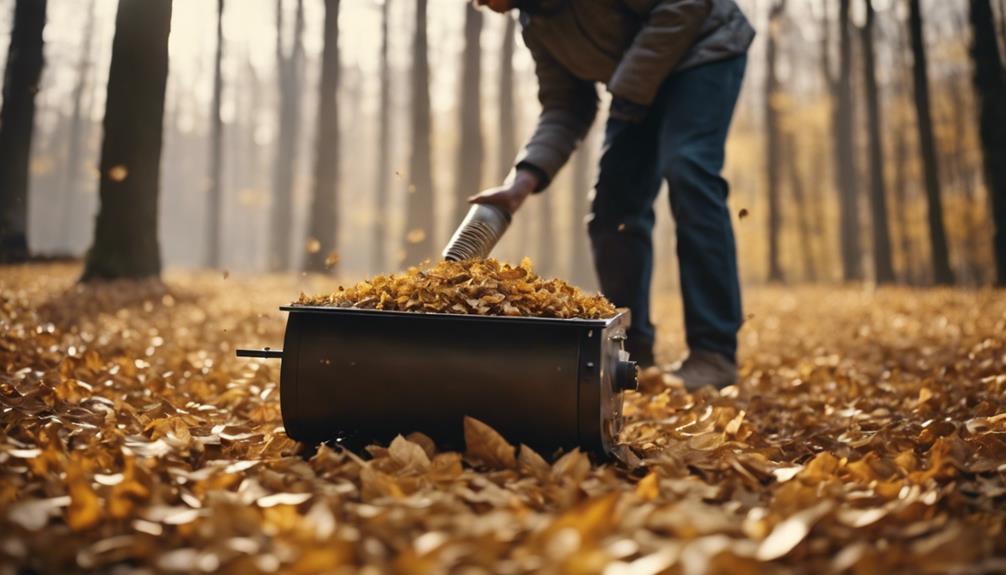
To prepare leaves for the smoker, we typically gather dry leaves from trees like maple, oak, olive, or eucalyptus and make sure they’re free from moisture to prevent sputtering or extinguishing.
Here are some steps to get your leaves ready for the bee smoker:
- Gather Dry Leaves: Choose leaves from suitable trees that are completely dry.
- Check for Moisture: Confirm the leaves are moisture-free to avoid any issues when lighting them.
- Crumple the Leaves: Create a loose, airy bundle by crumpling the dry leaves for easy ignition and sustained burning.
- Experiment with Types: Try different leaves to discover which ones burn well and produce the desired cool smoke effect for effective bee management.
Preparing leaves this way can help you create a calming environment for your bees during inspections.
Ensuring Leaf Safety for Bees
In using leaves in a bee smoker, we must guarantee the safety of our hardworking little friends.
It’s essential to select leaves from trees such as maple, oak, or eucalyptus, which won’t cause harm to the bees when burned.
Leaf Types Suitable
In selecting leaves for a bee smoker, our focus is on ensuring the safety and well-being of the bees. When choosing the right leaves, consider these options:
- Pine needle leaves: known for producing a gentle smoke.
- Dry grass clippings: helpful in creating calming smoke.
- White pine needles: effective for bee smoker use.
- Dry leaves: like those from maple or oak trees, can be safe options.
Using essential leaves is vital to prevent harm to the bees. Remember, the goal is to keep the bees calm during hive inspections. So, opt for leaves free from pesticides or contaminants to guarantee a smooth and safe smoking process for our buzzing friends.
Bee Smoke Impact
Leaves play a critical role in beekeeping practices, particularly in ensuring the safety and calmness of bees during hive inspections. When we use leaf fuel in a bee smoker, it produces natural smoke that has a calming effect on the bees.
Pine needles, known for burning quickly, are a fantastic leaf option for bee smokers as they’re easy to light. This natural smoke helps in gently moving the bees within the hive, making inspections easier and safer for both the beekeeper and the bees.
Safety Considerations
For the safety of the bees, it’s crucial to carefully select and prepare the leaves used in a bee smoker. When considering using leaves in a bee smoker, keep these safety considerations in mind:
- Opt for pine needle leaves, dry grass clippings, or other dry leaves like maple or oak for bee smoker fuel.
- Avoid leaves with chemicals or residues that could harm the bees when burned.
- Make sure the leaves are completely dry to prevent excessive smoke or sparks that may disturb or harm the bees.
- Choose leaves that burn cleanly and produce a consistent, cool smoke to effectively calm and manage bees during hive inspections.
Leaf Selection Considerations
When choosing leaves for a bee smoker, consider selecting dry options like olive tree leaves, pine needle leaves, or eucalyptus leaves. Dry leaves are essential for a successful beekeeping experience. They ignite easily, maintain a steady burn, and provide a consistent source of smoke. This not only helps in calming the bees but also facilitates your beekeeping tasks smoothly.
Dry grass clippings, white pine needles, and leaves from maple or oak trees are also great choices. Remember, avoiding wet or green leaves is vital to prevent excessive smoke and lighting challenges. So, opt for those dry leaves to keep your bees happy and your beekeeping activities running harmoniously.
Leaf Burning Techniques for Bee Smoker
Using various types of dry leaves in a bee smoker improves the efficiency of beekeeping tasks by providing a consistent and calming source of smoke. When burning leaves in a bee smoker, consider these techniques for best results:
- Pine needles: Burn quickly and are easy to light, making them convenient for starting the smoker.
- Dry leaves: Such as olive tree leaves, maple, or oak leaves, are effective in creating smoke to calm the bees.
- Bark: Add denser materials on top of easily ignitable leaves to guarantee a longer-lasting smoke.
- Grass clippings: Another effective option to fuel the bee smoker for hive inspections.
Experiment with different combinations to find the most suitable mix that suits your beekeeping needs.
Leaf Smoke Effects on Bees
Leaf smoke from burning various types of leaves in a bee smoker has an essential effect on bees during hive inspections. When we use pine needles or other leaves in the bee smoker, the resulting smoke helps soothe the bees, making it easier to work with them.
This important effect is vital for beekeepers during hive management and transportation. Pine needles, known for their quick burn and easy lighting, are a popular choice for bee smokers due to their effectiveness in generating this calming smoke.
Leaf Smoker Maintenance Tips
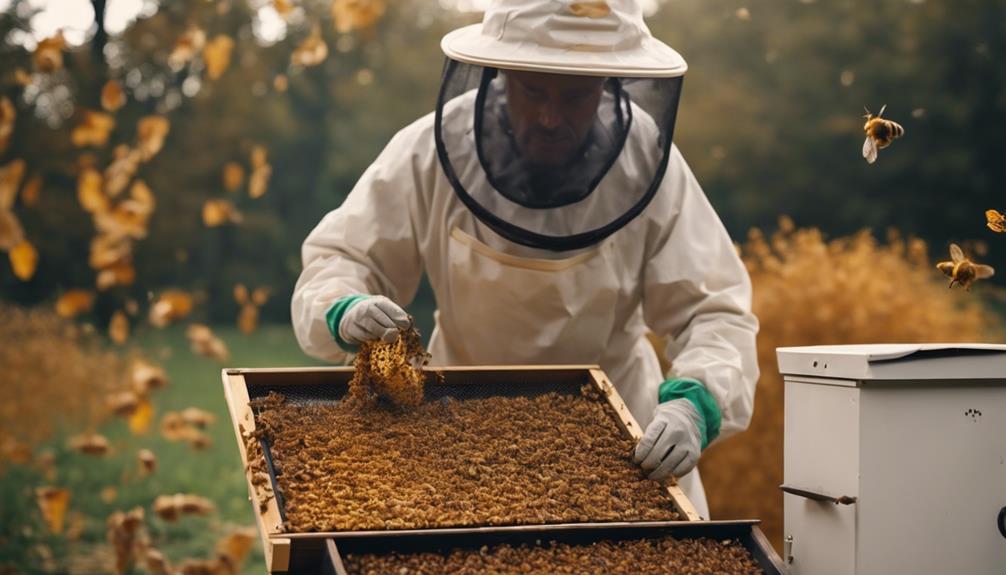
Routine maintenance of the bee smoker is essential for peak performance and beekeeping efficiency. When using pine needles or dry leaves as fuel, proper care guarantees a consistent burn and effective smoke production. Here are some maintenance tips to keep your bee smoker in top shape:
- Use Completely Dry Leaves: Moisture can hinder the burn, so make sure your fuel is thoroughly dry.
- Store Leaves Properly: Keep dry leaves in a well-ventilated area to maintain their flammability.
- Regularly Replace Old Leaves: Swap out old or damp leaves with fresh dry ones for best burning.
- Clean Out the Smoker: Remove ash and residue from burnt leaves to prevent clogging and maintain efficient smoke output.
Sustainable Leaf Sourcing Practices
To maintain eco-friendly beekeeping practices, sourcing dry leaves from trees like olive, pine, eucalyptus, maple, or oak is essential for sustainable bee smoker fuel.
Collecting leaves from fallen branches, garden mulch, or dry grass clippings promotes responsible and renewable leaf sourcing. These dry leaves not only offer a natural and eco-friendly fuel source but also help in calming bees during hive inspections.
By ensuring the sustainable harvesting of leaves, beekeepers can minimize their environmental impact while supporting the longevity of beekeeping methods. Utilizing leaves in a bee smoker isn’t only cost-effective but also efficient, allowing beekeepers to manage their bees effectively while keeping an eye on their environmental footprint.
Embracing these sustainable leaf sourcing practices is a step towards a greener and more responsible approach to beekeeping.

Roger Thomas is a seasoned beekeeper and hive architect with a deep-seated passion for sustainable living. His fascination with bees has shaped his professional career, giving him practical and theoretical expertise in bee behavior, colony health, and optimal hive conditions. Roger’s technical skills shine in his bespoke hive creations that cater to the specific needs of diverse bee species, while his sustainable practices promote environmental balance and the wellbeing of the bee population.
As he continues his journey in beekeeping, Roger has become a dedicated advocate for responsible practices and an insightful educator in his field. His posts aim to inspire new beekeepers, underline the importance of sustainability, and showcase the remarkable contribution bees make to our ecosystem. Roger invites you to join him as he delves into the world of bees and the rewarding, honey-sweet art of beekeeping.
